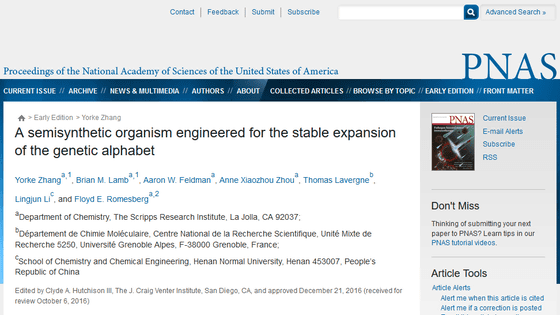Succeeded to maintain artificial base pairs in E. coli in vivo, leading to "new proteins" in the future

ByCaroline Davis 2010
Scripps Research Institute's Floyd Romesberg et al.Succeeded to incorporate an artificially created base pair into E. coli DNA and replicate exactlydoing. However, this artificial base pairIt can not survive unless a chemical substance is supplied from the outside, and it is excluded from DNA when this support is lostIt was. The research team further advanced the research, and finally succeeded in maintaining artificial base pairs in E. coli at last.
A semisynthetic organism engineered for the stable expansion of the genetic alphabet
http://www.pnas.org/content/early/2017/01/17/1616443114.abstract

New organisms have been formed using the first ever 6-letter genetic code - ScienceAlert
http://www.sciencealert.com/new-organisms-have-been-formed-using-the-first-ever-6-letter-genetic-code
Scientists create first stable semisynthetic organism
https://phys.org/news/2017-01-scientists-stable-semisynthetic.html
DNA is known to have a double helical structure in the cell. There are two base pairs in this structure, AT base pair by "A" (adenine) and "T" (thymine), GC base pair by "G" (guanine) and "C" (cytosine) . There have been attempts to add one artificial base pair to extend human intervention and expansion for more than 20 years, and the team of Scripps Research Institute led by Floyd Romesburg in 2014 is an artificial base pair Succeeded in producing E. coli with integrated.
However, since E. coli was unable to replicate artificial base pairs on its own, yok Chang and Brian Lamb, co-author of the paper, reported that proteins carrying chemical substances necessary for making artificial base pairs It has created a mechanism called "nucleotide / transporter" that can pass through the cell membrane of E. coli. However, the nucleotide transporter shortens the lifespan of E. coli, and E. coli can not continue to maintain it even if the incorporated artificial base pair is incorporated, it died soon.
Therefore, researchers repeated research and fixed the transporter. Also, in order to make artificial base pair copy easily, we optimized it by changing the molecule used for Y base formation.
In addition, the research team used CRISPR - Cas 9, an innovative genomic editing technology, to prevent "X" and "Y" molecules, which are the sources of artificial base pairs, from being identified as "intruders."
As a result, E. coli was healthy even in the state of incorporating the transporter, and it became possible to keep artificial base pairs.
Since Romezberg et al. Only demonstrated that "it is possible to incorporate artificial base pairs in Escherichia coli", there is no special meaning for the incorporated artificial base pairs, so the following can actually read the information We are considering incorporating artificial base pairs. In the future it is expected that this bacterium will be used as a source of medicine and ingredients to create "new protein".
Related Posts:
in Science, Posted by logc_nt







